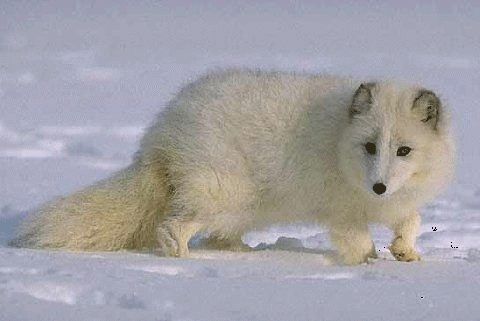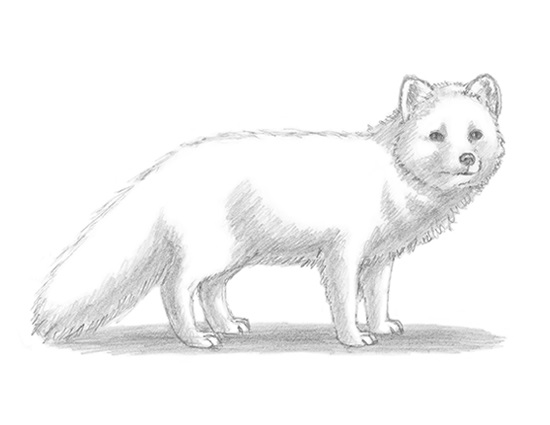


How to Draw an Arctic Fox
Please PAUSE the video after each step to draw at your own pace.
For the first few steps, don’t press down too hard with your pencil. Use light, smooth strokes to begin.
Step 1: Draw two circles as guides for the arctic fox’s body. The circles don’t have to be perfect. They’re just guides. The circle on the left should be a bit bigger, and their edges should touch.
Step 2: Draw a smaller circle on the top right side as a guide for the arctic fox’s head. The edges of these two circles should overlap just a little bit.
Step 3: Draw two intersecting lines inside the head to help you place the facial features later on.
Step 4: Draw a small circle on the lower part of the head as a guide for the arctic fox’s muzzle.
Step 5: Draw two arcs on top of the arctic fox’s head as guides for the ears.
Step 6: Draw two angled lines under the body (one below each circle) as guides for the arctic fox’s legs. Arctic foxes have short legs, so don’t draw the lines too long.
Step 7: Draw a series of curved lines that connect the major shapes to form the arctic fox’s body and tail. The guide for the tail is similar to a big U-shaped arc with a diagonal orientation on the left side of the body.
That’s it for the initial sketch! From this point on, press harder with your pencil to get a more defined sketch.
Step 8: Draw the eyes inside the arctic fox’s head using the lines as guides for placement. The shape of the eyes is similar to a football. Draw it lightly at first to get the shape right. Draw a tiny circle inside each eye to represent glare. Foxes have vertically oriented pupils like cats, so draw a thin slit inside each eye for the pupils. Draw a couple of lines on the sides of the arctic fox’s eyes to form the actual eyeball and shade the rest of the eye. Use a value that is lighter than the pupil to shade the rest of the eye. Draw a few small lines around the eyes for extra detail.
Step 9: Draw the arctic fox’s nose inside the muzzle using the lines and small circle as guides. First lightly sketch an oval. Then darken the top part and draw curved lines on the sides for the nostrils. Darken the bottom part and add a small line to split the nose.
Step 10: Use the small circle as a guide to draw the rest of the muzzle. Draw a line below the nose that splits in two to form the mouth. Use quick, short strokes instead of a solid line for a furry feel. Draw the side of the muzzle that goes up to the eye using quick, short strokes. Draw a few more lines under the mouth for the arctic fox’s chin.
Step 11: Use the shapes on top of the head as guides to draw the arctic fox’s ears. Darken the ear more and add a few short strokes within them to represent the fur inside.
Step 12: Use the original circle as a guide to draw the rest of the arctic fox’s head. Use quick, short strokes as you follow the basic path of the circle. Make the sides of the face a bit wider.
Step 13: Using the line as a guide, draw the front legs. Draw lightly at first to get the structure of the arctic fox’s leg right. When you’re happy with what you have, go ahead and darken it. Follow the basic path of the line as you thicken up the leg. Use a few curved lines at the end for the paw. Draw the leg on the other side the same way. Sketch lightly to get the structure right, then darken it using quick, short strokes. The base of the leg should be thick on top and thinner at the bottom. Don’t forget the paw at the end!
Step 14: Use the other line as a guide to draw the arctic fox’s hind legs the same way as the front legs. Sketch it out lightly first to get the structure right, then darken it using quick, short strokes for the fur. The hind legs angle back more and they’re thicker at the base. Draw the hind leg on the other side the same way.
Step 15: Use the remaining lines as guides to complete the rest of the arctic fox’s body and tail. Use quick, short strokes as you follow the basic path of the guide lines for a fluffy, furry feel.
Step 16 (optional): You can stop here for a sketchy look or erase as much as you can of the initial guide lines for a cleaner look. Don’t worry about erasing all of the guides. It’s okay to leave some behind. Also re-draw any final sketch lines that you may have accidentally erased.
Step 17 (optional): You can add some shading to your drawing to give it more dimension and volume. Pick the direction of the light source when shading so that the shadows are consistent with it. Vary the pressure on your pencil to get different degrees of tonal value. You can also add more value throughout your drawing for an arctic fox with a brown summer coat. For a winter coat, just stop after shading. It’s always a good idea to use reference for accuracy. And remember to PAUSE the video whenever you need help.
Step 18 (optional): Add a cast shadow underneath. This helps ground the fox so it doesn’t appear to be floating.


